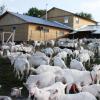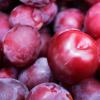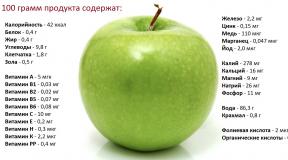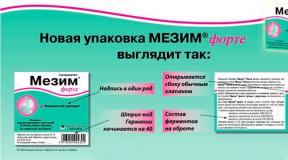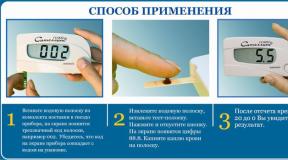Food gluten. Gluten - what is it and is it really harmful? List of gluten free foods. Hidden gluten in foods
Gluten: what is it, the harm of gluten, gluten-free recipes.
Recently, on the Internet you can see articles that are devoted to the dangers of gluten, as well as all kinds of gluten-free diets. What is gluten and why are there so many materials about its dangers and benefits? We will deal with these issues in detail in this article.
To deal with the health risks of gluten, let's start with the basics and find out what gluten is. The simplest definition of gluten will be as follows: this substance is a complex protein that is part of the chemical formula of cereal grains. The most gluten-rich grains are wheat, rye, oat and barley.
The second name of gluten is more common among the people - gluten. Due to the gluten in the flour, the dough is elastic and elastic, it rises quickly. Gluten is present in almost all types of baked goods, from regular bread to cakes. There is gluten in pasta and beer.
In addition, modern food manufacturers often add gluten to their products to make the finished product thicker and more appetizing. Gluten can be found in ketchups, sauces, sweets, french fries (store-bought), ice cream, dry broths and other concentrates, it is in a number of nutritional supplements and vitamins.
On food labels, gluten is most often cryptically referred to as modified food starch or hydrolyzed vegetable protein. People who are allergic to gluten should refrain from buying products with such a component.
 With a genetic intolerance to gluten in the human body, when eating products with this substance, a severe inflammatory reaction can occur. And in patients with celiac disease, the immune system will recognize gluten as a foreign protein and therefore will begin to fight it, affecting healthy tissues as well. In this case, the tissues of the stomach and intestines will suffer the most, which in turn is fraught with the development of pathologies in these organs. Brain tissue, heart muscle, and joint tissues may also be affected.
With a genetic intolerance to gluten in the human body, when eating products with this substance, a severe inflammatory reaction can occur. And in patients with celiac disease, the immune system will recognize gluten as a foreign protein and therefore will begin to fight it, affecting healthy tissues as well. In this case, the tissues of the stomach and intestines will suffer the most, which in turn is fraught with the development of pathologies in these organs. Brain tissue, heart muscle, and joint tissues may also be affected.
You should know that gluten intolerance can be not only obvious, but also hidden. Symptoms of an allergic reaction are so mild that they are attributed to food poisoning or other illness, and only a complete medical examination can help a specialist make a correct diagnosis.
The problem of gluten allergy in our time is incredibly relevant and can be observed even in absolutely healthy people. The explanation for the spread of the problem lies in the fact that over the past two centuries, cereals have been selected by breeders for further cultivation with a high content of vegetable protein, and as a result, modern wheat, rye and other cereals have the maximum concentration of gluten.
And if you are often worried about pain in the abdomen, there are problems with stools, you often feel tired and lethargic - you should see a doctor, as these symptoms in combination may indicate an allergic reaction to gluten.
 People with celiac disease will benefit from knowing what types of foods are gluten-free in order to make their diet right. We list products in which gluten is completely absent:
People with celiac disease will benefit from knowing what types of foods are gluten-free in order to make their diet right. We list products in which gluten is completely absent:
- all kinds of fruits and vegetables;
- oils of vegetable and animal origin;
- eggs, fish, meat, milk and dairy products;
- spices and spices (in its pure form!);
- buckwheat, potatoes, wild rice, millet, legumes and nuts.
A small note: some people go on a gluten-free diet for weight loss, but it is unlikely to be effective, because in order to lose weight, you need to exclude carbohydrates from your diet, and not protein, even if of plant origin.
 If you are forced to exclude foods containing gluten from your diet, then it will be useful for you to find out recipes for dishes that will not contain this type of vegetable protein.
If you are forced to exclude foods containing gluten from your diet, then it will be useful for you to find out recipes for dishes that will not contain this type of vegetable protein.
Such recipes can be found on various forums dedicated to combating celiac disease and healthy eating, and it should be noted that there are a lot of options for dishes that can be prepared without gluten: soups, salads, appetizers and main courses, and even pastries.
It should be noted that following a gluten-free diet, it is worth preparing dishes for your menu yourself, and not buying ready-made and semi-finished products in stores. This would be healthier, as gluten-free products from supermarkets, although they do not contain gluten, are rich in chemical flavor enhancers, emulsifiers and sugars, which are added by manufacturers in order to make the finished product more appetizing. and attractive to look at.
According to some sources, the use of gluten contributes to the formation of inflammation in the body, diabetes and obesity. Thus, all this leads to celiac disease. It is also associated with various emotional disorders, autism, indigestion, senility, deficiency of vitamins and minerals that come with food, etc.
celiac disease (gluten enteropathy) is a chronic and progressive disease without the use of diet therapy, characterized by atrophy of the mucous membrane of the small intestine as a result of intolerance to gliadin, a component of the gluten protein in wheat, rye and barley, and according to some reports, oats.
Severe celiac disease is manifested by persistent diarrhea with copious excretion of feces containing undigested fats, abdominal pain, with bloating from accumulated gases (flatulence), impaired digestion of food and absorption of nutrients with secondary nutritional disorders of the body - protein-energy malnutrition, hypovitaminosis, iron and vitamin B12-deficiency anemia, systemic osteoporosis, etc. With an erased course, the only clinical manifestations of celiac disease may be diseases that develop as a result of selective malabsorption of nutrients. The insidiousness of celiac disease lies precisely in its ability to proceed in an erased (malosymptomatic) form, masquerading as other diseases.
The cause of celiac disease is associated with a genetic defect in the formation in the small intestine of enzymes necessary for the breakdown of gliadin, and the latter acts on the intestinal mucosa as a toxin, damaging its cells. In addition, undigested gliadin triggers allergic-type immune reactions in the intestinal mucosa.
The active manifestation of celiac disease requires a combination of 3 factors: heredity, the presence of gluten in food and a trigger mechanism (emotional stress, pregnancy, surgery, viral infection). The main symptoms of the disease: abdominal pain, diarrhea, an increase in abdominal circumference, a change in appetite absence to a sharp increase, vomiting, weight loss, bone pain, apathy, skin itching, allergic skin and respiratory lesions, frequent viral diseases, anemia, nose or other bleeding . With a long course of unrecognized celiac disease due to gluten intoxication, severe secondary immune disorders begin: diabetes mellitus, mental retardation, chronic hepatitis, rheumatoid arthritis, adrenal insufficiency, uveitis, stomatitis, intestinal ulcers, tumors of the oral cavity and gastrointestinal tract, infertility and gynecological diseases, epilepsy and schizophrenia. Celiac disease has a 78 percent increased risk of cancer of the mouth, intestines, and esophagus. gazeta.aif.ru
When transferring patients to a lifelong diet with the exception of the above cereals, it is possible not only to stop intestinal disorders and improve the general condition of patients, but also to restore the mucous membrane of the small intestine. Full improvement usually occurs with adequate nutrition no later than 3 months from its onset. Thus, celiac disease is one of the few diseases in which timely diagnosis and proper diet can radically change the patient's condition and even save his life.
The absolute need for diet therapy for celiac disease is the complete and permanent exclusion from the patient's diet of all products from wheat, rye and barley: bread, flour and pasta, cereals, confectionery, sausages and any other products that include the flour of these cereals. Many nutritionists and gastroenterologists have recommended excluding all foods containing oats from the diet. However, studies of the last few years have shown that the inclusion of 40-50 g of oat products in the diet of patients with celiac disease does not lead to a deterioration in the condition of patients, nor to changes in the condition of the small intestine mucosa. This gave grounds for the conclusion about the safety of consumption of oat products by patients with celiac disease, in any case, in the indicated quantities. With celiac disease, foods and dishes made from rice, buckwheat, millet, corn, sago, and (with rare exceptions) from soy are well tolerated.
Many people today are phasing out gluten by introducing gluten-free foods into their diets. You should not mindlessly follow fashion, but it is better to learn more about the product. Gluten - what it is and why it is harmful to the body, everyone should know, because the product is found in the usual products from wheat and flour. Familiarize yourself with the term, the mechanism of action of the substance on the body and the dangers that it poses.
What is gluten
Wheat protein or gluten is included not only in wheat, but also in other cereal grains - rye, oats, barley. By its type, gluten (Greek for “glue”) is a sticky protein found in flour and other cereal products. When baking bread, a complex protein makes the dough elastic and viscous. Plus, it is an excellent preservative, so it is added to products to extend the shelf life, give volume, shape. A third of the products on store shelves contain gluten, which can be harmful to health.
What foods contain gluten
You can detect gluten in food when buying products made from grains of wheat, rye, barley and oats. Natural protein is found in the following products:
- bread;
- bakery products, pastries;
- pita bread;
- flour, muesli;
- cookies;
- cupcakes;
- bagels;
- cakes, pizza;
- oatmeal, Hercules;
- pasta;
- yogurt, chocolate;
- sausages, crab sticks;
- ketchups, ready-made sauces;
- traces can be found in ice cream, infant formula;
- sports healthy nutrition (protein);
- beer, strong alcohol from grain raw materials.
During the day, a person consumes up to 40 g of gluten, most of which falls on bread and pastries. Approximate amount of harmful substance in products:
in beer
Natural protein is found in barley, which is used to make malt for the subsequent preparation of beer. For a foamy drink, this substance is a natural preservative that gives a special taste and retains properties due to its specific structure (it does not dissolve in water, it only reacts with it, sticking together particles of water and flour). According to research, a dose of 350 ml of beer weekly increases the development of psoriasis due to gluten.
Gluten in bread
Wheat, rye, or mixed flour breads contain gluten. It is the main component of flour products. The protein mixes with the liquid and forms a liquid sticky mass, which helps to knead an elastic tight dough. Pastries and bread are airy, light, porous, with a crispy crust. Without gluten, kneading the dough becomes very difficult.
In baby cereals
Oatmeal, wheat and semolina porridge for the first feeding of children contain gluten. It is also found in cookies, crackers and baby food. Pediatricians recommend including these products starting from 5-6 months, and preferably from 9, so that the child's body can adapt to the intake of new substances and get used to potential allergens. The first cereals for babies should be rice, buckwheat or corn flour. When introducing gluten cereals, it is worth starting with half a teaspoon, and monitor the reaction. The reason for suspicion of intolerance will be a rash on the skin, diarrhea, constipation.
Pasta and dough dishes
Gluten is added to the pasta to give a thick, uniform consistency to the dough, which can be harmful. In addition to it, the composition of food products may contain wheat starch. You can determine the component in a simple way - put a little iodine on food and watch the color. If the color turns blue-black, there is starch in the composition. If a person is gluten intolerant, these foods should be avoided.
Alcohol
If alcohol for alcoholic beverages is made from grain, the finished product contains gluten. Wine, rum, tequila and sake, some varieties of vodka are considered safe. According to scientists, gluten in the alcohol of their grains may not be present if the correct distillation process is carried out. If the starter is added to an already finished product, there is a danger. Whiskey, bourbon, gin, beer are unsafe.
Sauces
To create a thick consistency of ready-made sauces (ketchups, mayonnaise), wheat starch is used. Gluten gives sauces an attractive taste and special structure, and extends the shelf life of the product. Safe in terms of gluten content are tomato paste (which contains only tomatoes), liquid sauces without flour and starch in the composition.
Hidden gluten in foods
You can detect traces of latent gluten in products by the names of the ingredients in the composition: modified food starch, textured vegetable protein or hydrolyzed vegetable protein. In cosmetics, products with vitamin E additives cause danger. Hidden gluten can be found in products that are sources of gluten:
- soup dressings;
- gravy;
- crisps;
- sweets, ice cream;
- soy sauce;
- bouillon cubes;
- spices;
- frozen vegetables, french fries;
- capsule vitamins, tablets;
- lipstick, powder, body lotions and face creams.
The benefits and harms of gluten
If a person does not have an intolerance to a substance, he can consume gluten, because it has the following benefits:
- valuable vegetable protein normalizes metabolism;
- gluten foods are rich in fiber, which has beneficial properties for cleansing the intestines;
- has nutritional value;
- contains useful substances, protein amino acids, vitamins A, E, group B, phosphorus, sulfur;
- helps children's immunity cope with food allergens.
In the presence of a food allergy to a protein or its intolerance, a person feels the negative effect of the component. What is harmful gluten for the body, according to doctors:
- With a genetic predisposition intolerance to gliadins (gluten fractions), inflammation develops, a chronic disease of celiac disease.
- Harmful due to the use of food with gluten - the walls of the small intestine, immunity, brain, heart, joints suffer.
The mechanism of action on the body
If a person is sick with celiac disease, getting into the human gastrointestinal tract, gluten breaks down to the metabolites glutenin and gliadin. The latter causes danger, it is harmful because it is attacked by the immune system, which perceives gliadin as a foreign microorganism. A substance similar in structure to the proteins of the tissues of the thyroid, pancreatic glands, with nerve and heart cells. Because of this, the entire body is affected.
Why the component is harmful: antibodies begin to be produced that destroy cells and tissues with proteins similar in structure to gliadin. This can lead to the development of goiter, diabetes, multiple sclerosis. Antibodies, attacking the walls of the intestine, destroy its cells, lead to digestive disorders, slow down the absorption of nutrients. The result is beriberi, micromineral deficiency, bloating, diarrhea, constipation, and increased intestinal permeability syndrome.
The last action causes increased danger. Leaky gut syndrome is the formation of tiny gaps in the intestinal mucosa, through which food debris and decay products of toxins are carried throughout the bloodstream, weakening the immune system. This leads to allergic reactions. Celiac disease is considered an autoimmune disease.
Scientists have proven that gluten molecules cause addiction by analogy with sugar (sugar addiction of a narcotic type). When they break down in the digestive tract, peptides are formed - gluten exorphins, which are harmful and similar in structure to opium and morphine. Exorphins activate opioid receptors in the brain. The body begins to "ask" for bread on an ongoing basis.
What is the danger of wheat protein
According to studies, gluten is harmful and dangerous in that it causes intolerance and celiac disease in a part of the population (1%). There is also an allergy to wheat protein, which manifests itself in adults and children. Gluten intolerance appears within 2-4 weeks after the introduction of foods containing it into the child's diet. The first symptoms are:
- stomach ache;
- diarrhea;
- lack of weight gain;
- increased capriciousness.
To completely eliminate the early development of intolerance, choose gluten-free foods for your child that do not contain wheat starch (potato and corn are allowed), refuse to include bread in the diet. Today, there is an acute problem of sensitivity to gluten, which has increased in products due to the conscious transition of people to wheat varieties with a high protein content. The human body is not adapted to digest grains of cereals, its enzymatic composition is insufficient.
celiac disease
If a person does not tolerate gluten, we can talk about the presence of celiac disease, which is harmful to the whole body. It affects approximately 1% of the population of any age. This is an indigestion in the small intestine resulting from an immune response to gluten. In a healthy person, the surface of the intestine is covered with villi that help absorb proteins and fats. In a celiac patient, gluten damages the intestinal villi, which lose their functionality. This slows down the absorption of nutrients.
The consequences are indigestion, thyroid damage, bone fragility, and an increased risk of cancer. Symptoms of the disease in an adult are diarrhea, bloating and weight loss. Additionally, anemia, fatigue, muscle and joint pain, and skin rash may be felt. Celiac disease is considered a genetic disease or manifests itself after stress and viral infections. At risk are pregnant women, patients who have undergone surgery.
Celiac disease (destruction of the villi of the small intestine) can be diagnosed by tests to determine genetic markers and special antibodies in the blood. Additional diagnostic methods are biopsy of the affected intestine and endoscopic examination. It is recommended to adhere to a gluten-free diet, to exclude from the diet foods that are harmful to humans. Treatment of the disease with drugs is impossible, only restriction in food will help. Healthy people do not need to follow a diet.
Hypersensitivity
In addition to celiacs, there is a group of people who experience similar symptoms of gluten intolerance. When checking, the diagnosis of celiac disease is not detected, but gluten intolerance is observed in the stomach. In this case, we can talk about hypersensitivity to gluten. Such people are advised to eat gluten-free food for about a month, and then return it to the diet and monitor the state of the body. If the symptoms have passed, it is worth continuing a diet that is not harmful.
Allergy to wheat
In addition to hereditary celiac disease and hypersensitivity to gluten, there is an allergy to wheat. Its manifestations are similar to the symptoms of diseases, but arise from the use of only one cereal crop. Signs of allergies include indigestion, eczema, asthma, and hay fever. Severe cases may present with anaphylaxis. Wheat allergy sufferers sometimes tolerate pure oats or barley without problems. The recommendation for patients is to exclude wheat products from food, which may be harmful to them:
- flour, bran, starch;
- bulgur, durum pasta, semolina;
- malt, starch, bread;
- cookies, muffins, pastries, crackers;
- cereal, couscous, breadcrumbs, pasta.
Gluten free diet food list
To avoid the manifestation of the negative effect of gluten on the body, patients with celiac disease, with signs of gluten intolerance and a common allergy to wheat protein, it is worth knowing about allowed and prohibited foods.
The deeper a person penetrates into the secrets of nature, the more often he is engaged in a kind of "witch hunt", that is, he is looking for some kind of substance that negatively affects his own health and life. Such products were considered in turn: carbohydrates, sugar, fats. In recent years, science has come to the conclusion that one of the most harmful substances consumed by humans along with food is gluten. It will be discussed in this article.
The fight against gluten
In Russia, the general consumer knows little about gluten. But Europe and America have advanced far enough in the study of this new "enemy" of humanity.
The most advanced personalities have already completely refused to eat gluten products. In any case, they think so. In health food stores, you can find products marked with a sign assuring that they are gluten-free. Now such products can be found in ordinary supermarkets. Some restaurants and cafes offer gluten-free menus. And modern hotels, focused on adherents of a healthy lifestyle, claim that this substance is not on their territory.
Definition

So what is it and what is it like? This substance has a Russian name: gluten. It is a vegetable protein found in various types of cereals. Most of all it is in oats, barley, rye and wheat. If you isolate gluten from the grain, you get a gray, tasteless sticky and elastic mass. It is thanks to her that flour, diluted with water, turns into dough, and after heat treatment, into lush pastries.
From a chemist's point of view, gluten is a mixture of protein enzymes, amino acids, and various types of peptides. There are several "white spots" in the chemical formula of this substance. This is due to the fact that components of a different origin adjoin the main protein chain in it. The physical and chemical properties of these compounds are not fully understood.
Properties
As mentioned above, thanks to gluten, flour can acquire a stable shape when water is added. Back in the last century, our grandmothers wallpapered the walls with flour paste. The paper stuck tightly. In this sense, gluten is sometimes much more effective than modern synthetic adhesives.
However, this is not the only advantage of this substance. Gluten gives baked goods softness and splendor. In addition, in its pure form, gluten is an excellent preservative. It helps keep bread fresh for much longer than nature intended. Modern species can be stored in plastic bags for several months. At the same time, they do not dry out and are not covered with mold.
gluten products

In the modern food industry, the use of gluten is becoming increasingly popular. In confectionery products (wafers, muffins), the gluten content reaches forty percent. And some varieties of long-term bread are fifty percent composed of this substance. In addition, gluten is often added to ready-made and semi-finished products, dairy and meat products. Instant pizzas, flour-based pasta definitely contain high amounts of gluten. Ham, dumplings, cutlets, small sausages, sausages, sausages - all these people's favorite products also cannot do without the addition of this substance. It is added to dairy products, especially curds and yoghurts. As a rule, gluten gives them the "delicate" taste.
Dangerous Consequences
So why is gluten bad? Why did America and Europe turn on him so much? It seems to be a wonderful product: it gives splendor and long-term preservation to rolls and bread, and makes dairy products more tender and tasty. It turns out that the whole point is the individual intolerance of the body of some people. There is such a disease - gluten intolerance. They gave it the name celiac disease.
The disease was first discussed in the 1990s. Then the babies, who were not even a year old, began to have dangerous symptoms: fetid stools, pain in the gastrointestinal tract, allergic reactions, bronchial asthma and dermatitis. Moreover, such problems began to haunt the children a couple of months after additional complementary foods were introduced into their diet. Gluten in baby food was then ubiquitous and contained in the first cereals: oatmeal and semolina.
Causes of the disease

Numerous studies have shown that sick babies have some kind of deviation in the body. It prevents gluten from being absorbed in the intestines. In such children, ominous symptoms appeared: the permeability of the walls of the small intestine increased, and large molecules of various components of fermentation and putrefaction in it began to enter the body. They began to injure the liver and other organs of the body. Doctors considered this condition dangerous not only for health, but also for the life of babies. Gluten in baby food was contraindicated for them. But, since intolerance to this substance was detected mainly in children of the first year of life, the researchers considered this deviation to be a genetic shift.
Excess gluten
Soon, however, adults began to arrive at the hospital. They experienced bloating, fetid diarrhea, muscular dystrophy and constipation. When gluten products were excluded from the diet of the victims, they completely got rid of terrible symptoms in one and a half to two months. At the same time, no medical treatment was applied to them. The insidious feature of gluten is that it has the ability to accumulate in the body for a long time. A person can eat gluten products for decades, unaware that their body is on the verge of a disease, and suddenly find themselves in the hospital with dangerous symptoms. Moreover, diagnosing celiac disease, which means applying adequate treatment, modern medicine can not always.
Is bread a dangerous product?
Once doctors figured out the cause of the dire symptoms that some people experience, gluten products have come under scrutiny. Bread has been blamed for causing celiac disease. However, in order not to harm the huge sector of the food industry, gluten intolerance was recognized as a genetic disease. Like, this is a disease that prevents the body of individuals from absorbing gluten.

But in reality, things look a little different. Celiac disease is not caused by a genetic disorder, but by gluten itself. That is a huge amount of synthetic gluten, which is now added to almost all foods. This theory is supported by several facts.
Firstly, in the modern world, bread is prepared using a completely different technology than several decades ago. In our childhood, this product did not keep for a long time, because only wheat gluten was present in it. This is a natural substance found in the composition of flour, from which bread is baked. Gluten additives were not allowed in those days. Its content in food did not exceed two percent. A similar amount of gluten is not capable of causing either an allergic reaction.
Secondly, synthetic gluten is added to modern bread. Only tens of grams of pure gluten can be extracted from one kilogram of wheat flour. And the cost of a natural product is quite high. Therefore, synthetic gluten is used in the current production of bread. This results in a cheap product with an optimally long shelf life. The sale of such goods brings the maximum profit to the manufacturer.
It can be concluded that the synthetic origin of gluten, as well as its huge amount in modern foods, causes celiac disease in both adults and children.
How to protect yourself
Nowadays, it is impossible to completely eliminate gluten products from the diet. A person, of course, can stop buying goods in the store and eat food grown in his own garden, but this method is not suitable for everyone.

Therefore, it is important to monitor what food enters our body. Doctors recommend minimizing the consumption of products that contain gluten flour, that is, bakery and confectionery products. It is better not to buy cheap white bread, it is better to choose whole grain varieties. You should also not abuse semi-finished products, sausages or sausage. Of course, the proposed solution to the problem is not a panacea, but just one way to protect your health from the costs of modern food production.
Konnyaku - a dietary product
Interestingly, the ability of gluten not to be digested in the body is used in dietary nutrition. In Japanese cuisine, gluten cakes are prepared. They are called konnyaku, after the plant from which they are processed. The technology for preparing this dish is complex.

First, fresh konjac root is cut into slices and dried, then crushed and synthesized from it a chemical compound called mannan oligosaccharide. Then special flour is made from it, which, when mixed with water and a coagulant (milk of lime), takes on a jelly-like appearance. From the resulting substance, gluten cakes are formed. It is difficult for an unaccustomed person to appreciate this product. The food has no taste or aroma. But in Japan it is quite a popular and sought-after product. Apparently, natural gluten in moderation is not only not harmful, but even beneficial to health.
Now you know what gluten is and how not to fall into its insidious networks. Unfortunately, it is difficult to stop eating fast food. Gluten-free cereals, which take only five minutes to create, are a great opportunity to quickly satisfy your hunger. However, it should be remembered that nothing in this world is given for free. And the time saved can later turn into serious health problems.
Gluten is a very popular protein product, but gluten-free products are increasingly being found on store shelves. But not all buyers know what gluten is in products and is it harmful at all? Perhaps gluten-free food is not particularly different from products with this additive? Let's figure it out. To begin with, it is worth defining what gluten is and why it is harmful.
At its core, this substance is gluten, a complex protein and is usually found in cereal products. Chemically speaking, gluten is a tasteless, pliable mass of gray color. The gluten compound also includes various amino acids, proteins, and peptides. To completely eliminate this substance from the diet, it is important to know which cereals contain this substance. As a rule, these are oats, wheat, triticale, rye, and also barley.

Is this substance harmful?
Gluten can harm the body with a disease called celiac disease. This disease manifests itself in violation of some intestinal functions, in particular absorption. However, this disease is not very common and occurs in only one percent of humanity. But intolerance to this substance is much more common, especially in newborns. It differs from celiac disease in that a person's stomach simply refuses to digest gluten, which causes bloating or other unpleasant things. What can be attributed to the symptoms that characterize the intolerance of this substance:
- abdominal pain, discomfort, bloating,
- prolonged diarrhea or constipation,
- strong smell of feces
- liver problems,
- joint diseases,
- stomatitis,
- general restlessness, anxiety,
- back pain,
- dermatitis or skin diseases,
- limb numbness.
Why is this protein harmful after 40 years?
A special risk group is made up of people after forty years, since it is at this age that the stomach becomes somewhat weaker, it is already more difficult to digest gluten. Very often, intolerance to this substance manifests itself in adulthood, even if a person has been absolutely healthy all his life and had no problems with digestion. That is why people after forty should pay increased attention to their well-being and visit a doctor when the first symptoms appear.

What cereals do not have this protein?
The list is:
- corn flour,
- Wheat flour,
- buckwheat,
- italian millet,
- quinoa,
- amaranth,
- montina.
Porridge from these cereals will fit perfectly into the diet and help to maintain the correct amount of carbohydrates. And by grinding cereal grains into flour, you can bake gluten-free bread yourself.
What foods contain this protein
In addition to bread and cereals, gluten is added to a huge number of other products. It can be found in ketchups, sauces and dressings, gravies, and ice cream. This is done in order to give the product mass a shape, to make it thicker and more plastic. In addition, the process of extracting gluten from grain does not require a lot of money, so it is very profitable for manufacturing companies. Gluten is practically insoluble in water, so in order to separate this protein from starch, the grain is soaked in water. When combined with a liquid, it forms fibers, and it is they who subsequently increase the density and elasticity of finished products. Meat products contain gluten in their composition - various semi-finished products and sausages. It is necessary to create minced meat so that the future product is strong and dense. It is also added to icing and breading for cutlets - this ensures their sticking and decorates the appearance. When fried, foods with this protein do not lose their shape, do not crumble and become crispy.
Well, if everything is more or less clear with food, then drinks raise questions. What is gluten in beer and why is it added there? In fact, they don’t add it on purpose, of course. But, as you know, beer is brewed from barley, and barley contains this protein. Alcoholic beverages such as vodka, whiskey, gin and bourbon can also contain it, because cereals are often used for their production. Does coffee contain gluten? Ordinary, natural - no. But its various substitutes, coffee flavors and fillings contain.

Among other things, this protein is almost always present in tablets and nutritional supplements, as well as in breakfast cereals that contain fruit pieces, nuts, bran or fat. In such breakfasts, this protein is added in order to enrich them with protein - this helps to bind other substances together. In this case, both just gluten and soy flour are used. Gluten is also added to dairy products, because they need density. For example, in the production of processed cheese, a combination of gluten and soy protein is used. Various cheese products, when gluten is added, become more similar to natural ones in appearance and taste.
Products containing gluten and lactose: table
|
The name of the cereal |
Percentage of gluten |
| Wheat | 80,00% |
| Rye | 15,70% |
| Barley | 22,50% |
| oats | 21 % |
| Oatmeal or Hercules | 12 % |
| Semolina | 50 % |
| Wheat groats | 80 % |
| Pasta | 11 % |
| Bread and buns | 7 to 80% |
| Cookies | 27 % |
| Candy products | 1 % |
| Biscuit | 20 to 40% |
| Khlebtsy | From 20% and above |
| Gingerbread | 7-8% |
| Crackers | From 10% and above |
| Sushi and bagels | 20 to 50% |
| Ice cream | 2 to 20% |
| Chocolate | 1 % |
| Mayonnaise | 2 % |
| Cheese or curd mass | 1 % |
| Condensed milk | 2 % |
| Yoghurts | 1 % |
| Powdered milk | 1 % |
| Sausages and similar products | 1 to 7% |
| Cheese and cheese products | 1 % |
Gluten Free Life: Diet
Of course, it is impossible to remove all foods containing this protein from the diet. That is why dietitians have established an allowable rate of the substance specifically for people with celiac disease and gluten intolerance. In our country, this norm is approximately 50 grams, but in Europe much less is allowed - only 20 grams. A diet without this protein does not allow eating certain foods at all, however, in addition to allowed and prohibited foods, there are also dangerous foods with a low content of gluten.





